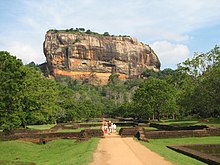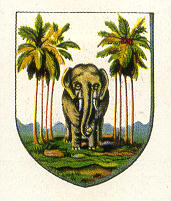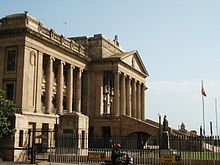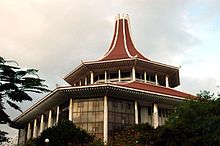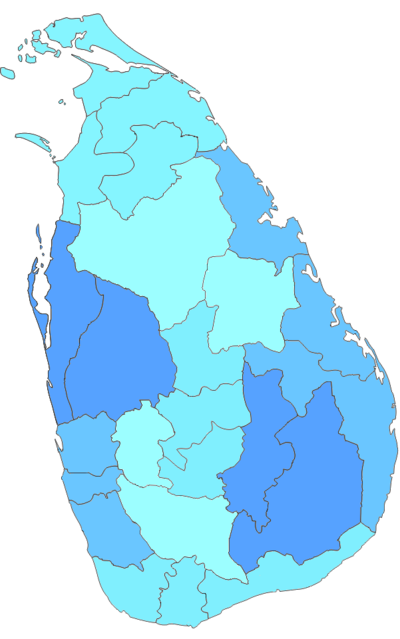Sri Lanka
Sri Lanka , officially the Socialist Democratic Republic of Sri Lanka (in Cingalés, ශ්රී ලංකා ප්රජාතාන්ත්රික සමාජවාදී ජනරජය ජනරජය , romanized: Sri Lanka Prajathanthrika Samajavadi Janarajaya; in Tamil, இலங்கை சனநாயக சோஷலிசக் குடியரசு , Romanized: ileṅkai caṉanāyaka cōṣalisak kuṭiyarasu ), is a sovereign country island located in South Asia, whose form of government is the semi-presidential republic. Its territory is organized into nine provinces and twenty-four districts. Its capitals are Kotte; it houses the seat of the legislature and Colombo; which houses the headquarters of the executive and judicial powers, the latter being the most populous city and seat of government in the country.
The island was known in ancient times as «Lanka», «Lankadvīpa», «Simoundou», «Taprobane”, “Serendib” and “Selan”, becoming popularly known as the “island of a thousand names”. During its colonization, the island took the name Ceylon, which continued to be used afterwards. Its particular shape and its proximity to India led to its being called "The Tear of India".
Due to its location in the path of major shipping lanes, Sri Lanka is a strategic naval link between West Asia and Southeast Asia, and has been a center of Buddhist religion and culture since ancient times. Today it is a multi-religious and multi-ethnic country, in which almost a third of the population is a follower of religions other than Buddhism, especially Hinduism, Christianity and Islam. The Sinhalese community is the majority. The Tamils, who are concentrated in the north and east of the island, constitute the largest ethnic minority. Other communities include Muslim Arabs, Malays, and the Burghers.
Famous for the production and export of cinnamon, tea, coffee, rubber and coconut, Sri Lanka boasts a progressive modern industrial economy and the highest per capita income in South Asia. Sri Lanka's natural beauty in its tropical forests, beaches and landscape, as well as its rich cultural heritage, make it a world famous tourist destination.
After more than two thousand years of local rule by kingdoms, parts of Sri Lanka were colonized by Portugal and the Netherlands beginning in the 19th century XVI, before control of the entire country was ceded to the British Empire in 1815. During World War II, Sri Lanka served as an important base for the Allied forces in the fight against the Japanese Empire. A nationalist political movement arose in the country at the beginning of the XX century, in order to obtain political independence, which was finally granted by the British after peace negotiations in 1948.
Sri Lanka's history has been marked for more than two decades by ethnic conflict between the national government and the insurgent movement the Liberation Tigers of Tamil Eelam. At the beginning of 2002, the two sides in the conflict agreed to a ceasefire, which was repeatedly broken by both parties. At the beginning of 2009, the national government began an offensive against the Tigers, which lasted several months and resulted in the annihilation of the guerrillas and the death of their high command, but at a very high cost of civilian lives.
History
Antiquity and Middle Ages
The prehistoric inhabitants of Sri Lanka were the Veddahs. The Sinhalese arrived on the island in the 4th century BC. C., probably from the northern part of India, and developed a civilization with cities like Anuradhapura and Polonnaruwa.
Tamil people from southern India also came to the island but the time, manner and numbers are unknown. In the 13th century, there was a Tamil society in the north and many fishing communities along the north coast of the island. The Tamils developed a different culture and politics than the Sinhalese. Relations between these two peoples have always been complex, between wars and ceasefires and invasions in both directions.
Buddhism was introduced to the island in the 3rd century BCE. Buddhism forged a new civilization in Sri Lanka after the arrival of Arahat Mahinda Thera, son of Emperor Asoka, who ruled the Magadha Empire in India. Devanampiya Thissa, the king at the time of the arrival of Mahinda Thera, embraced Buddhism and facilitated its development by building temples throughout the country.
South Indian rulers, mostly of Tamil descent, attacked Sri Lanka several times beginning in the 3rd century BCE. C. Occasionally, these invasions resulted in the installation of a Tamil government in the northern part of the island for a time. In the opposite direction, several Sinhalese kings retook the capital and withdrew the Tamil invasion.
European colonization
In the year 1505 a Portuguese fleet appeared under the command of Lourenço de Almeida. The capital was then fixed at Sri Jayewardenepura (Kotte) when the coastal regions were occupied by the Portuguese in the 16th century. In 1517 another Portuguese, Lopes Soares de Albegaria, obtained permission from the King of Kotte to found a colony.
The domination of the Portuguese was long, until the arrival in 1602 of the Dutch expedition of Joris de Spielleag. The Dutch managed to found a colony at Kottiar, but were driven out by the Portuguese. In 1638-1639 a new Dutch expedition destroyed the Portuguese forts to the east of the island and gradually conquered the entire territory.
The coastlines were occupied by these countries, the interior of the island remained independent, with its capital in the city of Kandy.
The British were also interested in controlling the island, sending an embassy to the King of Kandy from Madras (India) in 1763, without obtaining any results. Then they tried again through Monroe, who in 1782 seized Trincomalee, territory that shortly after was conquered by the French and restored to the Netherlands. In 1795 another British expedition, under Stewart's command, arrived from Madras and reoccupied Trincomalee. Later, they did the same with Jaffna, Kalpitaya, Nigamuva and Colombo, expelling the Dutch from these territories. The entire island was occupied by the British Empire in 1796 according to the Kew charters and officially became a colony in 1802, through the Peace of Amiens, adopting the name of Ceylon (Ceylon in English) and annexing the presidency of Madras.
Between 1817 and 1848 there were various uprisings that were severely suppressed. The last of these, which was the bloodiest, was promoted by the Buddhist enemies of Lord Torrington's government. The rebels were almost completely wiped out.
Independence
Ceylon became independent in 1948. In 1972 it changed its name to Sri Lanka and became a republic, severing its last ties with Great Britain. In 1978, the legislative and judicial capital was moved from Colombo to Kotte. The flag was also changed, welcoming a representation of the Tamil and Muslim minority populations (orange and green bars on the left side of the flag).
Tensions between the majority Sinhalese and the minority Tamil began in 1983, after the murder of 13 Sri Lankan army soldiers in Jaffna. This fact caused riots throughout the country and the death of hundreds of Tamils in just three days; many of them became refugees. Tens of thousands of inhabitants have died on both sides during the ethnic war that has marked the history of this country.
A ceasefire was signed in December 2001. Norway acts as a mediator in the peace process. The LTTE was declared a terrorist movement by the United States, the United Kingdom, Australia, Italy, India and Canada, within the global fight against terrorism that began in that year. This situation contributed to the movement accepting a ceasefire.
The effects of the December 2004 tsunami were very severe. The south and east coasts of the country were devastated, tens of thousands of people died and a significant number were displaced.
On April 21, 2019, it suffered the worst terrorist attack in its history, in which 290 people lost their lives in a chain of attacks on four luxury hotels and three churches.
Since 2021, it has been going through an economic crisis due to the pandemic, the country's economic mismanagement, which has caused a liquidity crisis, a shortage of consumer goods and a general feeling of malaise. This situation led to the assault on the presidential palace and the resignation of the prime minister. [1]
Government and politics
The Constitution of Sri Lanka establishes a unitary state under democratic rule: the Socialist Republic of Sri Lanka. The government system is semi-presidential. The President of the Republic is also Head of State, Commander-in-Chief of the Armed Forces and President of the Government (jointly with the Prime Minister), and is popularly elected for a five-year term. In the exercise of his duties, the president reports to Parliament, which is a unicameral legislature of 225 members. The president appoints his cabinet of ministers from among the elected deputies. The prime minister leads the ruling party in Parliament and shares many executive responsibilities, mainly in domestic matters.
Parliament has the legislative power. Deputies are elected by universal suffrage. Elections are held every five years. Parliamentary representation is based on a proportional system by districts, with a particular rule: the party that receives the majority of the vote in each electoral district, also wins an "extraordinary seat". The president can convene, suspend or close a legislative session and dissolve Parliament at any time after its first year of session.
On July 1, 1960, the people of Sri Lanka elected the world's first female prime minister: Sirimavo Bandaranaike. Her daughter, Chandrika Kumaratunga, has served in various governments as prime minister and as president between 1999 and 2005.
Sri Lanka has enjoyed, along with India, the longest period of parliamentary democracy in a non-Western country. Politics in Sri Lanka is controlled by rival coalitions led by the left-wing New Democracy Front and the centre-right Alliance of United Freedom Parties. There are other minority parties, such as the Buddhist Party, the Socialist Party and the Tamil nationalist parties, which oppose the separatism of the Liberation Tigers of Tamil Eelam, but demand autonomy and greater regional rights.
Since 1948, Sri Lanka has been a member of the United Nations. It is also part of the Non-Aligned Movement, the Colombo Plan, the Asia-Pacific Economic Cooperation Forum and the South Asian Association for Regional Cooperation.
During the Cold War, Sri Lanka followed a foreign policy of non-alignment, drawing its positions closer to the United States and Western Europe.
Armed Forces
The Sri Lankan Armed Forces, under the direction of the Ministry of Defence, consists of the Army, Navy and Air Force. Since the 1980s, the army has led the government's response against the Marxist militants of the JVP and now the militant forces of the Liberation Tigers of Tamil Eelam. Sri Lanka receives considerable military aid from Pakistan, China, the United States and the United Kingdom.
The Sri Lanka Army is organized into three branches under the Ministry of Defence: Army, Navy and Air Force. Since its independence, however, its primary missions have been anti-insurgency measures, against armed groups within the country, most notably the LTTE, and at one point the former nationalist rebel group, JVP.
It grew from a ceremonial force after independence from the British Empire to a highly trained and highly motivated armed force. The training and sophistication of the Sri Lankan armed forces have helped fight tough battles against one of the world's most dangerous armed groups, the LTTE, which is classified as a terrorist organization in some 32 countries. The Sri Lankan Army has taken part in many wars throughout its history, including the Second Boer Wars and both World Wars (under British command). Today they stand out for having fought the separatist guerrillas from the north, who attacked with the famous "Black Cats": women who carry out suicide attacks hugging their victims before detonating themselves.
Political-administrative organization
| Administrative divisions of Sri Lanka | |||||||
|---|---|---|---|---|---|---|---|
| Province | Capital | Area (km2) | Population | ||||
| Central | Kandy | 5674 | 2 556 774 | ||||
| East | Trincomalee | 9996 | 1 547 377 | ||||
| North Central | Anuradhapura | 10 714 | 1 259 421 | ||||
| North | Jaffna | 8884 | 1 060 023 | ||||
| Northwest | Kurunegala | 7812 | 2 372 185 | ||||
| Sabaragamuwa | Ratnapura | 4902 | 1 919 478 | ||||
| South | Galle | 5559 | 2 465 626 | ||||
| Uva | Badulla | 8488 | 1 259 419 | ||||
| Western | Colombo | 3709 | 5 837 294 | ||||
Geography and climate
- “Sri Lanka (isla)” redirects here.
The island of Sri Lanka is in the Indian Ocean, southwest of the Bay of Bengal and southeast of the Sea of Oman. It is separated from the Indian subcontinent by the Gulf of Mannar and the Palk Strait, often called Adam's Bridge. According to Hindu mythology, a bridge from land to the Indian mainland, known as Rama Bridge, was built during Rama's time by the vánara architect Nala. According to historical records, the natural passage was once a complete isthmus - and therefore Sri Lanka was a peninsula - but was affected by a violent storm, probably a cyclone, in the year 1480. Today it is formed by a series of peninsulas, islands and underwater banks of sand and limestone. The width of the Palk Strait is small enough that the Sri Lankan coastline is visible from the Indian village of Rameswaram on Pamban Island, off the Indian mainland.
The pear-shaped island has an area of 65,610 km², and is equivalent to slightly less than the area of Andalusia, the province of Formosa or the state of Nuevo León. It consists mostly of plains and coastal plains, with high mountains only in the south-central part. These include Adam's Peak and the highest point, Mount Pidurutalagala (also known as Mount Peter), at 2,524 metres. The Mahaweli Ganga River, the Kalu and other streams drain the island and provide fresh water to the islands. cities and agriculture.
Located between 5º and 10º north latitude, its climate is tropical, moderated by ocean winds, and with considerable humidity. Temperatures range from 15°C in Nuwara Eliya in the Central Highlands (where it is covered in snow or fog, which can occur for several days in winter) to 32°C in Trincomalee on the coast northeast (where temperatures can reach 38 °C). The average annual temperature for the country as a whole fluctuates between 28 and 30 °C. Day and night temperatures can vary from 4 to 7 °C. In January, the coolest month, many people wear coats and sweaters in the highlands and elsewhere. The hottest period precedes the summer monsoon rains. The pattern of rainfall is influenced by monsoon winds from the Indian Ocean and the Bay of Bengal, which meet the slopes of the central highlands, causing heavy downpours on the mountain slopes and in the south-west of the island. Part of the windward slopes receive up to 2,500 mm of rain per month, but the leeward ones in the east and northeast receive little rain. Periodic gusts and tropical cyclones with rain and cloudiness occur in the southwest, northeast, and eastern parts of the island. Between December and March, monsoon winds from the northeast bring moisture from the Bay of Bengal. Humidity is typically highest in the southwest and mountainous regions, and depends on seasonal rainfall patterns. In Colombo, for example, humidity stays above 70% year-round, rising to almost 90% during the monsoon season in June. In contrast, Anuradhapura experiences only 60% during the March monsoon, but rises to 79% during the November and December rains. In the highlands, daytime humidity in Kandy is generally between 70 and 79%.
Fauna and flora
Wildlife
Sri Lanka's wildlife is among the most varied in the world: leopards, water buffalo, monkeys, elephants, porcupines, pangolins, black bears, sambar and axis deer, in the national parks. Whales, dolphins, swordfish and turtles on the coast. In the lagoons and mangroves we will find crocodiles, salamanders, toads, monitor lizards, water monitors and snakes, such as pythons and cobras that also occupy other habitats. And in the chapter on birds, the gray heron, cormorants, ibis, pelicans, flamingos, etc., and several endemic species such as the Ceylon thrush and the yellow-eared bulbul stand out. Sri Lanka is an ornithologist's paradise.
It is normal to find, along the roads and in the cultivated fields, elephants working in agricultural and transport work. But as far as fauna is concerned, the most visible animal is the monkey (common Langur), since it lives in the temples and stupas in large numbers, taking advantage of the food that the faithful deliver to the temple in the form of offerings, since they consider this sacred species and identify it with the Hindu god Hanuman.
15% of the territory is dedicated to the protection of nature and wildlife: 92 species of mammals, 435 birds, 107 fish, 81 reptiles and 242 butterflies approximately. The protected areas of Bundala National Park, Udawalawe National Park, Yala National Park, Horton Plains National Park and the Sinharaja Forest Reserve declared a World Heritage Site by UNESCO stand out.
Flora
This beautiful island contains different microclimates, benefiting from the monsoon and its location on the globe, from the tropical with its orchids and palm trees, to the mountainous with its pine trees and tea crops. Not in vain is it home to two of the trees considered "exceptional" in the world.
- Ficus benjamina (approx. 140 years and 1900 m2) Kandy. Located in the botanical garden of Kandy, one of the most beautiful on the planet.
- Faithful"Bo tree", Anuradhapura. It is a cutting of the tree under which Buddha attained enlightenment. It's a sacred species for Buddhism.
It is famous for its botanical gardens and known as the island of spices for its crops of cloves, cinnamon, cardamom, vanilla, etc. Also noteworthy are plantations of certain species, such as ebony, teak and mahogany, which produce some of the most prized wood in the world.
Economy
Economy during the colonization of European countries
During the periods of occupation and colonialism by the different European countries, the fragile and weak economy of the island allowed the circulation of different foreign currencies. To legalize this practice, these pieces were counter-marked with different initials or signs. When the island was occupied by the Dutch, in the town of Galle the double and single Portuguese coins were marked with the aim of increasing their value by 10 and 5 stuivers respectively. The Persian coins that were on the island were also countermarked, thus allowing their legal circulation. In this way the great abassi of 5 shahi was worth 22 ½ stuivers, the abassi of 4 shahi; 18 stuivers and ½ abassi; 9 stivers. When in 1658 the Dutch occupied the Portuguese town of Jafna, they marked the double and single thongs with the aim of ensuring their circulation. The first major counter-mark to be used throughout the territory was that used by the Dutch East India Company (Van Verre Ostindische Compagnie: V.O.C.) around the years 1783-1808. In addition to the initials “V.O.C.”, this countermark also contained the letter “C”, which referred to the name of the island. There are Reales de a 8 Spaniards, thalers from María Teresa I of Austria and 5 francs from Napoleon with this curious mark. After the Dutch occupation, the British invaded the island again. It is believed that they countermarked coins again, but there is no evidence that they used the same marks as before.
In the 19th and 20th centuries, Sri Lanka became a plantation economy, famous for its production and export of cinnamon, Ceylon rubber and tea, which stuck as a national export trademark. The development of modern ports under British rule increased the island's strategic importance as a center of trade. During World War II, the island had important military installations for the Allied forces. However, the plantation economy exacerbated poverty and economic inequality.
Economy since independence
From 1948 to 1977 socialism totally influenced the economic policies of the government. Colonial plantations were dismantled, industries were nationalized, and a welfare state was established. While the standard of living and the ability to read and write improved appreciably. But despite the war, the country's gross domestic product grew by almost 5% a year in the last 10 years, development policies made GDP grow by almost 7% a year between 2006 and 2008.
In 1977, the UNP government began to incorporate privatization, deregulation [citation needed]and the promotion of private enterprise. While the production and export of tea, rubber, coffee, sugar and other agricultural goods is still important, the nation has moved steadily towards an industrialized economy with the development of processed foods, textiles, telecommunications and finance. In 1996, plantation crops accounted for only 20% of exports and have declined further, to 16.8% in 2005 (compared to 93% in 1970), while textiles and clothing have reached a 63% GDP grew at an average annual rate of 5.5% in the early 1990s; a drought and worsening security situation slowed growth to 3.8% in 1996. The economy rebounded in 1997-2000, with growth averaging 5.3%. The year 2001 saw the first economic contraction in the country's history, as a result of low purchasing power, budget problems, global lag, and ongoing civil dissension. Signs of recovery appeared after the 2002 truce. The Colombo Stock Exchange reported the highest growth in the world for 2003, and today Sri Lanka has the highest per capita incomes in South Asia.
In April 2004, there was a sharp reversal in economic policy after the government led by Ranil Wickremesinghe of the United National Party was defeated by a coalition between the Sri Lankan Freedom Party and the Janatha Vimukthi Peramuna, leftist-nationalist, calling this union the Alliance for the Freedom of People. The new government stopped the privatization of state companies, reformed the power of the State, the oil utilities and embarked on an economic subsidy program that it called the Perata Rat. Its main theme, sustaining rural and suburban SMEs and protecting the domestic economy from outside influences, such as oil prices, the World Bank and the International Monetary Fund. But this policy of subsidizing the goods that require fuel, fertilizer and wheat. In 2004 Sri Lanka alone spent approximately US$180 million on a fuel subsidy, as fuel price fixing had been an election promise. To finance the increase in the budget deficit arising from a range of subsidies and public procurement of the sector, the government eventually had to print R 65 billion (US$650 million) or about 3% of GDP. [citation needed]Expansionary fiscal policy, coupled with loose monetary policy, ultimately pushed inflation to 18% in January 2005, referenced to the price index for Sri Lankan consumption.
Sri Lanka's per capita income has doubled since 2005. During the same period, poverty fell from 15.2% to 7.6%, the unemployment rate dropped from 7.2% to 4, 9%, Colombo Stock Exchange market capitalization has quadrupled, more than 90% of homes in Sri Lanka are electrified. 87.3% of the population has access to drinking water and 39% has access to water pipes. Income inequality has also declined in recent years, indicated by a Gini coefficient of 0.36 in 2010.
Demographics
The majority of the population is Sinhalese (83%), followed by Tamils (8.9%) and Arabs (7.7%). The official languages are Sinhala and Tamil. English is the mother tongue of approximately 10% of the population and is widely spoken and understood. These three languages are used in education and administration.
In 1921 the population reached 4.5 million inhabitants, which increased to 6.6 million in 1946 and, at the end of the century XX, to 18.5 million. Migration flows occur mainly from east to west, towards the city of Colombo, and there is also significant foreign migration, especially to the United Kingdom.
Languages
Several languages are spoken in Sri Lanka within the Indo-Aryan, Dravidian and Austronesian families. Sri Lanka grants official status to Sinhala and Tamil. The languages spoken in the island nation are deeply influenced by the various languages in India, Europe, and Southeast Asia. Arab, Portuguese and British settlers have influenced the development of modern languages in Sri Lanka.
Religion
Sri Lanka has a multi-religious and multi-ethnic population. The religious division is made up of Buddhists (69%), Hindus (16%), Muslims (7.6%), and Christians (7.5%).
Buddhism, mainly that of the Theravada school, constitutes the religious faith of about 70% of the population. According to traditional Sri Lankan chronicles (such as the Dipavamsa), Buddhism was introduced to Sri Lanka in the 2nd century BCE. C. by the son of Emperor Ashoka, during the reign of King Devanampiyatissa. At this time and under the patronage of this Sri Lankan king, a scion of the Bodhi Tree itself was brought to Sri Lanka, under which the Buddha received enlightenment from it and the first monasteries were established. The Pali Canon (Thripitakaya), previously preserved as an oral tradition, was first written in Sri Lankan around 30 BCE. c.
Sri Lanka has the longest continuous history of Buddhism of any of the predominant Buddhist nations, with the Sangha largely intact since its introduction in the 17th century II. During its periods of decline, the Sri Lankan monastic lineage was revived by contact with Thailand and Burma. Periods of Mahayana influence, as well as official neglect under colonial rule, have presented great challenges to Sri Lanka's Theravada Buddhist institutions, but their continued revivals—most recently in the XIX— have kept the Theravada tradition alive for more than 2000 years.
Hinduism, brought to Sri Lanka by immigrants or frequent invaders from South India, is the second largest religion in Sri Lanka, mainly of the Shaivite school, constituting 15% of the population.
Islam was brought to the island by Arab traders over many centuries and today its adherents number 8%.
Christianity, introduced to the island by European settlers in the 16th century, has been embraced by 6% of the population.
There was also a small portion of followers of Zoroaster, who came from India (Parsis), who settled in Ceylon during the period of British rule, but as a result of emigration few of them remain, having, however,, played a significant role in the growth of the country. Sri Lanka's last finance minister, Nariman Choksy, was a Parsi.
Religion plays an important part in the life and culture of Sri Lankans. Most Buddhists observe Puja Days once a month, according to the lunar calendar. In turn, Hindus and Muslims also observe their own holidays. In Sri Lanka there are many Buddhist temples, mosques, Hindu temples and churches throughout the island, especially in areas where their respective communities are concentrated. Buddhists are distributed in almost all but the north of the island, while Hindus are concentrated in the north, east and central highlands. Christians, especially Catholics, are mainly concentrated in the western coastal belt. Muslims are concentrated in various groups along the coast and in the interior. All religious communities are represented, in large numbers, in the western province and in other urban centers.
Sports
Sri Lanka's national sport is volleyball, although cricket is also very popular. Other sports are also practiced, such as football, water sports, athletics, rugby and tennis, but less than the first two mentioned.
The Kit Premier League is the football league of Sri Lanka, with the main teams being Blue Star SC, Saunders SC and Negombo Youth SC. The national team has not achieved any transcendent result, its greatest victory being a 7-1 against Pakistan.
As for the Olympic Games, the national team has won two silver medals, both in athletics: Duncan White at the 1948 London Olympics and Susanthika Jayasinghe at Sydney 2000.
Contenido relacionado
Berlin
Tenerife
Santa Cruz Province
